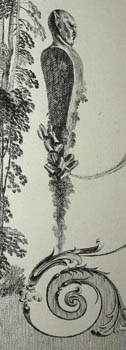Description
The title alludes to Momus, a name associated with a few divergent characters in Greek mythology. The version of Momus illustrated in this print is the female deity who suggested to Zeus that he arrange for the sea goddess Thetis to marry a mortal — hence the water and seashell motifs in the design. Nonetheless, inasmuch as most of the titles of Watteau’s works were not recorded until after his death when prints of them were published, it is not know for certain if Watteau had Momus in mind when creating this composition.
According to Martin Eidelberg, an art historian and expert on Watteau, few of Watteau’s arabesques survive, though some were made into larger paintings or wall and ceiling decorations. The principle records of these works are posthumous engravings such as Les Enfans de Momus published by Watteau’s dealer Edme-François Gersaint. Eidelberg discusses an example of this print, in the Bibliothèque Nationale de France, Paris, identical to the one offered, in an article entitled How Watteau Designed His Arabesques. Eidelberg’s analysis of extant engravings and drawings demonstrates that Watteau drew various studies of elements found in his arabesques, then explored different compositions from these motifs in related designs, working “quite freely, combining elements from different sources, rifling through his sheets of studies until he found the motif required.” For example, Les Enfans de Momus shares elements with other Watteau arabesques, notably Le Galant and La Cause Badine. Collectively, posthumous engraved works such as these were influential as source material for architects and decorative arts designers working in the Rococo style.
Jean-Antoine Watteau was a leading exponent of Rococo painting and influential figure in 18th-century art despite his early death at age 37, especially in France and England. He invented the genre, the “fête galante,” depicting elegant people socializing in a park or garden setting. According to the Grove Dictionary of Art, “[h]is particular originality lies in the generally restrained nature of the amorous exchanges of his characters, which are conveyed as much by glance as by gesture, and in his mingling of figures in contemporary dress with others in theatrical costume, thus blurring references to both time and place.”
Inscription lower border: Paris chez Gersaint pont Nôtre Dame et chez Surugue rue des Noyers avec privilege du Roi [Paris, house of Gersaint, Notre Dame Bridge, and house of Surugue, Rue des Noyers, with privileges of the King]
Numbered “2,” lower right margin.
Condition: Generally fine, professionally lightly cleaned and deacidified, now with only faint light toning and wear.
References:
Eidelberg, Martin. “How Watteau Designed His Arabesques.” Cleveland Studies in the History of Art, Vol. 8, (2003), pp. 68-79.
Glorieux, Guillaume. À L’Enseigne de Gersaint: Edme-François Gersaint, Marchand d’Art sur le Pont Notre-Deame (1694-1750). Seyssel, France: Champ Vallon, 2002. p. 235. Online at Google Books. http://books.google.com/books?id=xT6iL4OBX1wC (31 May 2010).
Jean-Antoine Watteau. The Grove Dictionary of Art. New York: Macmillan. 2000. Online at Artnet.com. http://www.artnet.com/library/09/0908/T090853.asp (31 May 2010).










